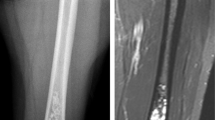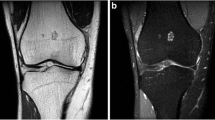Abstract
Objective
It has been widely postulated that enchondromas arise from cartilage remnants that have been displaced from the growth plate into the metaphysis. However, this theory remains unproven. Based on the common occurrence of enchondromas on routine knee MR imaging (2.9 %), one would expect to find displaced cartilage in the metaphysis of skeletally immature individuals on routine knee MR examinations if the above theory was to be supported.
Materials and methods
The electronic databases of a specialist orthopedic hospital and children’s hospital were searched for skeletally immature patients who underwent MR imaging of the knee for a variety of indications. Individuals with Ollier disease or hereditary multiple exostoses were excluded. The MR images were subsequently reviewed by a musculoskeletal radiologist for evidence of displaced cartilage into the metaphysis.
Results
We reviewed 240 MR examinations of the knee that were performed in 209 patients. There were 125 MR studies in male and 115 MR examinations in female patients (age range: 5 months–16 years; median age: 13 years). In 97.1 %, the growth plates around the knee demonstrated a regular appearance. Seven cases (2.9 %) in six patients showed cartilage extension from the growth plate into the metaphysis, which remained in continuity with the growth plate. There were no cases of displaced cartilage into the metaphysis on MRI.
Conclusions
Our study challenges the widely believed theory that enchondromas arise from displaced growth plate remnants.



Similar content being viewed by others
References
Unni KK. Chondroma. In: Dahlin's bone tumors: general aspects and data on 11,087 cases. Philadelphia: Lippincott-Raven, 1986: 25–45.
Giudici MA, Moser Jr RP, Kransdorf MJ. Cartilaginous bone tumors. Radiol Clin North Am. 1993;31:237–59.
Resnick D, Kang HS. Internal derangements of joints: emphasis on MR imaging. Philadelphia: WB Sanders Co, 1997:745.
Kransdorf MJ, Peterson JJ, Bancroft LW. MR imaging of the knee: incidental osseous lesions. Magn Reson Imaging Clin N Am. 2007;15:13–24.
Walden MJ, Murphey MD, Vidal JA. Incidental enchondromas of the knee. AJR Am J Roentgenol. 2008;190:1611–5.
Brien EW, Mirra JM, Luck Jr JV. Benign and malignant cartilage tumors of bone and joint: their anatomic and theoretical basis with an emphasis on radiology, pathology and clinical biology. II. Juxtacortical cartilage tumors. Skeletal Radiol. 1999;28:1–20.
Freyschmidt J, Ostertag H, Jundt G. Knorpelbildende Tumoren. In: Freyschmidt J, Ostertag H, Jundt G, editors. Knochentumoren mit Kiefertumoren: Klinik - Radiologie - Pathologie. Berlin Heidelberg New York: Springer; 2010. p. 273–442.
Greenspan A, Remagen W. Tumors of Cartilaginous Origin. In: Greenspan A, Remagen W, editors. Differential diagnosis of tumors and tumor-like lesions of bones and joints. Philadelphia: Lippincott-Raven; 1998. p. 123–203.
Jaffe HL, Lichtenstein L. Solitary benign enchondroma of bone. Arch Surg. 1943;46:480–93.
Mirra JM. Intramedullary cartilage- and chondroid-producing tumors. In: Mirra JM, Picci P, Gold RH, editors. Bone tumors: clinical, radiologic and pathologic correlations. Philadelphia: Lea & Febiger; 1989. p. 439–690.
Aoki J, Sone S, Fujioka F, et al. MR of enchondroma and chondrosarcoma: rings and arcs of Gd-DTPA enhancement. J Comput Assist Tomogr. 1991;15:1011–6.
Cohen EK, Kressel HY, Frank TS, et al. Hyaline cartilage-origin bone and soft-tissue neoplasms: MR appearance and histologic correlation. Radiology. 1988;167:477–81.
Laor T, Jaramillo D. MR imaging insights into skeletal maturation: what is normal? Radiology. 2009;250:28–38.
Milgram JW. The origins of osteochondromas and enchondromas. A histopathologic study. Clin. Orthop. Relat Res 1983; 264–84.
Stoller DW. Diagnostic imaging: orthopaedics. Salt Lake City, Utah: Amirsys; 2004.
Benign bone tumors. In: Greenfield GB, Arrington JA, eds. Imaging of bone tumors: a multimodality approach. Philadelphia: JB Lippincott Co, 1995:193.
Virchow R. Die krankhaften Geschwülste. Berlin: Verlag von August Hirschwald; 1863.
Virchow R. Über die Entstehung des Enchondrom und seine Beziehung zur Ecchondrosis und Exostosis cartilaginea. Monatsberichte der Königlich Preussischen Akademie der Wissenschaften 1875;760–773.
Bullough P. Bone disease resulting from disturbances in mineral homeostasis. In: Bullough P, editor. Orthopaedic pathology. St. Louis: Mosby; 2004. p. 199–220.
Ecklund K, Doria AS, Jaramillo D. Rickets on MR images. Pediatr Radiol. 1999;29:673–5.
Quan AW, Beall DP, Berry ER, Ly JQ, Sweet CF, Fish JR. A case of osteochondritis dissecans in rickets. Emerg Radiol. 2005;11:219–21.
Scherer E. Exostosen, Enchondrome und ihre Beziehung zum Periost. Frankfurt Ztschr F Path. 1928;36:587–605.
Speiser F. Ein Fall von systematisierter Enchondromatose des Skeletts. Virchows Arch. 1928;258:126–60.
Chang CY, Shih C, Penn IW, Tiu CM, Chang T, Wu JJ. Wrist injuries in adolescent gymnasts of a Chinese opera school: radiographic survey. Radiology. 1995;195:861–4.
Laor T, Wall EJ, Vu LP. Physeal widening in the knee due to stress injury in child athletes. AJR Am J Roentgenol. 2006;186:1260–4.
Liebling MS, Berdon WE, Ruzal-Shapiro C, Levin TL, Roye Jr D, Wilkinson R. Gymnast's wrist (pseudorickets growth plate abnormality) in adolescent athletes: findings on plain films and MR imaging. AJR Am J Roentgenol. 1995;164:157–9.
Shih C, Chang CY, Penn IW, Tiu CM, Chang T, Wu JJ. Chronically stressed wrists in adolescent gymnasts: MR imaging appearance. Radiology. 1995;195:855–9.
Laor T, Hartman AL, Jaramillo D. Local physeal widening on MR imaging: an incidental finding suggesting prior metaphyseal insult. Pediatr Radiol. 1997;27:654–62.
Grogan DP, Love SM, Ogden JA, Millar EA, Johnson LO. Chondro-osseous growth abnormalities after meningococcemia. A clinical and histopathological study. J Bone Joint Surg Am. 1989;71:920–8.
Kleinman PK, Marks Jr SC, Spevak MR, Belanger PL, Richmond JM. Extension of growth-plate cartilage into the metaphysis: a sign of healing fracture in abused infants. AJR Am J Roentgenol. 1991;156:775–9.
Weinmann JP, Sicher H. Tumors of skeleton. In: Weinmann JP, Sicher H, editors. Bone and bones. St. Louis: C.V. Mosby; 1955. p. 405–7.
Aigner T, Dertinger S, Vornehm SI, Dudhia J, Von der Mark, Kirchner T. Phenotypic diversity of neoplastic chondrocytes and extracellular matrix gene expression in cartilaginous neoplasms. Am J Pathol. 1997;150:2133–41.
Aigner T. Towards a new understanding and classification of chondrogenic neoplasias of the skeleton–biochemistry and cell biology of chondrosarcoma and its variants. Virchows Arch. 2002;441:219–30.
Amary MF, Bacsi K, Maggiani F, et al. IDH1 and IDH2 mutations are frequent events in central chondrosarcoma and central and periosteal chondromas but not in other mesenchymal tumours. J Pathol. 2011;224:334–434.
Conflict of interest
The authors declare that they have no conflicts of interest.
Author information
Authors and Affiliations
Corresponding author
Rights and permissions
About this article
Cite this article
Douis, H., Davies, A.M., James, S.L. et al. Can MR imaging challenge the commonly accepted theory of the pathogenesis of solitary enchondroma of long bone?. Skeletal Radiol 41, 1537–1542 (2012). https://doi.org/10.1007/s00256-012-1387-4
Received:
Revised:
Accepted:
Published:
Issue Date:
DOI: https://doi.org/10.1007/s00256-012-1387-4




